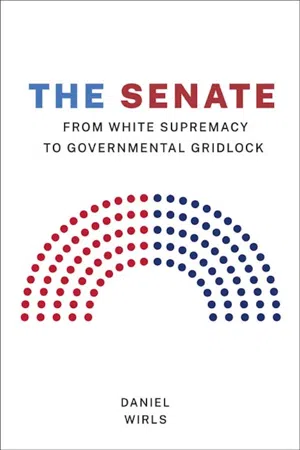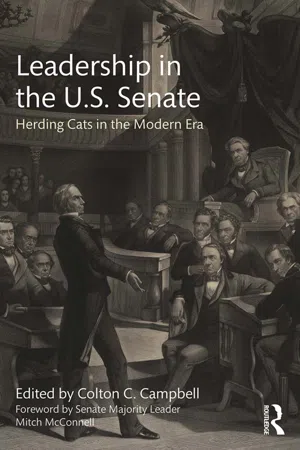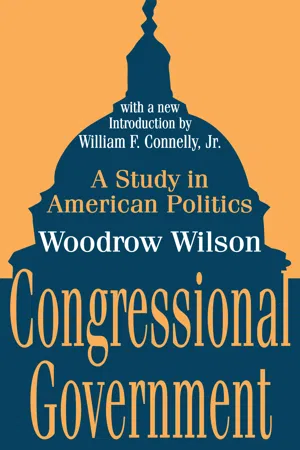Politics & International Relations
Senate
The Senate is one of the two chambers of the United States Congress, with each state being represented by two senators. It plays a crucial role in the legislative process, including confirming presidential appointments and ratifying treaties. The Senate also has the power to conduct impeachment trials and has a significant influence on shaping national policies and laws.
Written by Perlego with AI-assistance
Related key terms
7 Key excerpts on "Senate"
- eBook - ePub
Constitutionalism and Democracy
From White Supremacy to Governmental Gridlock
- Daniel Wirls(Author)
- 2021(Publication Date)
- University of Virginia Press(Publisher)
1 The Senate was placed at the crossroads of the national system of separated institutions sharing power and at the intersection of state and national sovereignty. First, the Senate was half of a bicameral Congress endowed with legislative power. Second, it shared in the executive power of appointments and treaties, with a potentially decisive role in the composition of the Supreme Court. Finally, the politics of the Constitutional Convention added another special purpose—the Senate would be the institutional embodiment of federalism and state power in the national government. It was to be the smaller, wiser, and more detached legislative chamber, the institutional home of state power and state equality and the quasi-council to the executive on appointments and treaties. In this way the Senate became the crucible for resolving several of the thorniest problems of American constitutionalism. In particular, the Senate was exceptional for the manifest tension and outright contradictions between its roles as both a Senate of far-sighted and detached national statesmen and a Senate of delegates sent by self-interested state legislatures. That tension was at the heart of the Constitutional Convention, and from the time the Senate first achieved a quorum, on April 6, 1789, to today, it has never been resolved.Its rich mixture of purposes and powers continues to make the Senate unique among the world’s political institutions. As the equal partner in one of the world’s most independent and robust legislatures, it is the most powerful upper house in the world. Whereas many countries have unicameral legislatures or upper houses or Senates with significantly less power or even only symbolic importance, the US Senate combines a formidable array of institutional characteristics and powers that make it distinctive and autonomous. The higher age and citizenship requirements for members, as well as the longer and staggered terms, contribute, more or less, to differences in the character of the upper house compared to the lower. Similarly, state equality in the Senate contrasts sharply with the proportional representation of the House. The distinctions produced by elections are reinforced by the institutional elements. The House and Senate are granted nearly equal powers; in fact, the Senate has a few exclusive powers, including the approval of treaties and appointments, that give it a singular status among upper houses. And unlike many upper houses, the modern Senate has enjoyed at least equal (un)popularity and (dis)respect among the people.2But it is this hybridity and complexity that have allowed the Senate over the years to conflate the various aspects of its constitutional role into a generalized idea that it has a special and different purpose that transcends the multiple but carefully defined roles given it by the Constitution. In particular, senators have drawn on and distorted the collection of attributes and responsibilities outlined above to justify what became the dominant feature of the Senate: its rules of procedure, which create and protect minority power, and the effect of those rules on Senate behavior. Modern senators have tended to portray minority power, as structured by Senate rules of procedure, as the sine qua non and raison d’être of their institution. This goes directly against what the Constitution actually mandated. The constitutional means to the end of better deliberation—first and foremost its smaller size, but also the age of senators and their length of citizenship, longer terms, and, originally, selection by state legislatures—have, over time, been displaced in favor of rules created by the Senate that empower minority obstruction. - eBook - ePub
- Joseph Barthelemy, J. Bayard Morris(Authors)
- 2020(Publication Date)
- Routledge(Publisher)
Chapter VThe SenateThe Senate of the 1875 Constitution was modelled, at least so far as concerns its general character and authority, on the Chamber of Peers of the Restoration and July Monarchy, and this Chamber of Peers had itself been modelled on the English House of Lords.According to the purposes of the Constitution the Senate is primarily a deliberative assembly, and it must exercise its influence in favour of moderation and stability. Its duty is to oppose at least a temporary resistance to the unconsidered enthusiasms of the Chamber of Deputies, who are younger, more numerous, and represent a more direct expression of universal suffrage.In order to play this part successfully important rights have been conferred upon it, which are in principle the same as those of the Chamber of Deputies. Thus the initiation of laws can proceed from a Senator just as well as from a Deputy; and the government can at its pleasure submit the draft of a law to the Senate or to the Chamber.There are, however, certain exceptions to this rule concerning the equality of the two assemblies. The first is directly imitated from the English Constitution, namely, that finance bills must first be brought before the Chamber of Deputies and passed by them. The Chamber, it is said, has a right of priority in financial matters; but it must be insisted that this preference is, in theory, one of priority and nothing more. For several years, however, the Chamber of Deputies has adopted the custom of putting off the budget vote to the last moment before it comes into operation, in such a way that the Senate at the penalty of having to start the year without a budget finds itself forced to rush through the examination of the budget referred to it by the Chamber, Usually the Senate accepts it with very slight modifications, though raising at the same time periodic but vain protestations against this manoeuvre of the people's Chamber. There is no valid reason for this inferiority of the Senate, since, unlike the House of Lords, whose rules have been rather blindly imposed upon it, the Senate represents, doubtless somewhat indirectly, the whole body of taxpayers. - eBook - ePub
Leadership in the U.S. Senate
Herding Cats in the Modern Era
- Colton C. Campbell(Author)
- 2018(Publication Date)
- Routledge(Publisher)
1Legislating in the Senate
From the 1950s into the 2000s
Mark J. Oleszek and Walter J. Oleszek 1The United States Senate, according to James Madison’s oft-quoted metaphor, is “the great anchor of Government.” His view is predicated on the ability of the Senate to hold fast against unwanted House-passed measures or the public passions of the moment. The Senate is an institution well-equipped to block and stymie action on measures and matters because the chamber’s permissive rules grant large procedural prerogatives to every member regardless of party or seniority. To engage in lengthy debate and to propose germane or non-germane amendments are traditional rights accorded each senator. A single senator, a small group, or the minority party has the capacity to slow down decision-making or to stop legislation outright.When Senator Robert J. “Bob” Dole (R-KS) was the minority leader, he stressed the importance of the Senate’s emphasis on minority rights: “The rights of the minority in the Senate are precious; they protect not just the interests of a partisan minority, but also the interests of economic and geographic minorities, including individual states. Those rights have been exercised by both parties as well as a combination of Republicans and Democrats.”2 On the other hand, the chamber’s emphasis on minority rights allows opponents to block action on proposals favored by a large majority of senators as well as many in the general populace.Unsurprisingly, lawmaking in the Senate can be difficult because it is easier to block than enact legislation. This reality complicates the ability of the top party leaders—especially the majority leader, who sets the chamber’s agenda—to process the chamber’s business in a timely manner. Moreover, the majority or minority leaders of the Senate, who consult regularly in determining the chamber’s schedule of activities, have an array of other important internal and external functions beyond trying to make the legislative trains run on time. Internally, as an example, the top Senate leaders are responsible for mobilizing winning coalitions to accomplish the legislative goals of their party as well as other high priority measures (e.g., bills addressing unexpected crises). Externally, party leaders are active in campaigning for party colleagues, acting as public spokesmen for their side, and raising campaign funds to ensure that their party either retains or claims majority control of the institution. - eBook - ePub
Poli Sci Fi
An Introduction to Political Science through Science Fiction
- Michael A. Allen, Justin S. Vaughn(Authors)
- 2016(Publication Date)
- Routledge(Publisher)
With its massive collection of voices and its apparent inability to include all voices, the Galactic Senate seems destined to fall apart as a representative body. The Senate requires a better institutional structure, notably better rules surrounding debate and political inclusion, in order to truly function as a representative body. Unfortunately, these are not the only structural problems the Senate faces. As we will see below, the Galactic Senate not only fails to represent its citizens, but it is also unable to carry out its own directives. I Cannot Fight a War for You The first of two factors that shape a legislature’s power is the legal powers it is given as well as the actual resources it has to carry out those legal responsibilities. To expand on how legislative capacity hinges on both legal rules and administrative resources, it is useful to turn to the American example. Starting first with legislative reach, this is really a discussion of federalism, or how policymaking responsibilities will be divided between national and local legislative bodies. In practice, political power in a society exists along a continuum. At one extreme, political institutions can be organized in a unitary fashion, where a single actor at the national level holds all power. At the other end of this continuum is a confederal system, where most power is local and divided among many local political actors. In each of these systems, the reach of the legislature can vary wildly – from granting legislatures a great deal of power in the former to a more restricted set of powers and policy arenas in the latter. 7 The U.S. Constitution lays out a number of formal federal powers – including coining money, building post roads, and providing national defense – while turning all other powers over to the state governments - eBook - ePub
Professionals or Part-timers?
Major Party Senators in Australia
- Peter van Onselen(Author)
- 2015(Publication Date)
- MUP Academic Digital(Publisher)
CHAPTER 1
The Australian Senate and Party System
Unique internationally, partially understood domestically
In modern Australian politics, attention paid to the Senate usually focuses on the role of minor parties and independents. The so-called cross-bench senators usually control the balance of power in the nation’s upper house, which explains why the media (and academia) devotes so much attention to their roles. But what about major party senators? Senators representing the Liberal National parties and the Australian Labor Party have consistently held upwards of 80 per cent of Senate positions since the introduction of proportional representation more than 65 years ago. The 2013 election saw the total fall fractionally below this percentage, but with mooted electoral reforms designed to sure up major party Senate numbers, the dominance of the major parties in the Senate is certain to continue. Despite this dominance, we know very little about the role major parties expect of their Senate team. Australia’s Senate is unique and yet the focus of studies of the Australian Senate have centred on the minority players, rather than the overwhelming majority of major party senators who dominate the chamber.Legislative elites
There is a substantial international literature on the roles and role perceptions of legislative elites (see, for example, Fenno 1978; Rose 1981; Fenno 1990; Searing 1994). Such studies sometimes focus on political systems with weak bicameralism and consequently do not focus on upper house representation. Searing (1994) examines the roles of MPs in the British parliamentary system. He divides his analysis into two halves: backbencher roles and leadership roles. The text is a valuable contribution to better understanding the functions of the individuals who operate the political system, but it does not spend much time exploring the roles of House of Lords representatives, operating in a weak parliamentary chamber. Fenno’s (1990) study of United States senators contributed to knowledge about representation in the strongly bicameral system of the United States. As in his previous study on Congressional representatives (1978), Fenno followed US senators on the campaign trail, describing their activities and analysing how senators campaign within the United States political system. However, his study provides very limited guidance for the study of Australian senators, owing, among other reasons, to the very different electoral systems within which Australian and American senators operate. United States senators are directly elected in a one-on-one contest every six years. There are only two senators representing an entire US state in the Federal Senate, as compared with twelve senators for each Australian state. US senators are therefore highly accountable to their electorates, and their tenure is in no way secured by a de facto list PR system as it is in Australian Senate contests. - eBook - ePub
Congressional Government
A Study in American Politics
- Woodrow Wilson(Author)
- 2017(Publication Date)
- Routledge(Publisher)
“The value, spirit, and essence of the House of Commons,” said Burke, “consists in its being the express image of the feelings of the nation;” but the image of the nation’s feelings should not be the only thing reflected by the constitution of a free government. It is indispensable that, besides the House of Representatives which runs on all fours with popular sentiment, we should have a body like the Senate which may refuse to run with it at all when it seems to be wrong — a body which has time and security enough to keep its head, if only now and then and but for a little while, till other people have had time to think. The Senate is fitted to do deliberately and well the revising which is its properest function, because its position as a representative of state sovereignty is one of eminent dignity, securing for it ready and sincere respect, and because popular demands, ere they reach it with definite and authoritative suggestion, are diluted by passage through the feelings and conclusions of the state legislatures, which are the Senate’s only immediate constituents. The Senate commonly feels with the House, but it does not, so to say, feel so fast. It at least has a chance to be the express image of those judgments of the nation which are slower and more temperate than its feelings.This it is which makes the Senate “the most powerful and efficient second chamber that exists,” 1 and this it is which constitutes its functions one of the effectual checks, one of the real balances, of our system; though it is made to seem very insignificant in the literary theory of the Constitution, where the checks of state upon federal authorities, of executive prerogatives upon legislative powers, and of Judiciary upon President and Congress, though some of them in reality inoperative from the first and all of them weakened by many “ifs” and “buts,” are made to figure in the leading rôles, as the characteristic Virtues, triumphing over the characteristic Vices, of our new and original political Morality-play.It should, however, be accounted a deduction from the Senate’s usefulness that it is seldom sure of more than two thirds of itself for more than four years at a time. In order that its life may be perpetual, one third of its membership is renewed or changed every two years, each third taking its turn at change or renewal in regular succession; and this device has, of course, an appreciably weakening effect on the legislative sinews of the Senate. Because the Senate mixes the parties in the composition of its Committees just as the House does, and those Committees must, consequently, be subjected to modification whenever the biennial senatorial elections bring in new men, freshly promoted from the House or from gubernatorial chairs. Places must be found for them at once in the working organization which busies itself in the .committee-rooms. Six years is not the term of the Senate, but only of each Senator. Reckoning from any year in which one third of the Senate is elected, the term of the majority, — the two thirds not affected by the election, — is an average of the four and the two years which it has to live. There is never a time at which two thirds of the Senate have more than four years of appointed service before them. And this constant liability to change must, of course, materially affect the policy of the body. The time assured it in which to carry out any enterprise of policy upon which it may embark is seldom more than two years, the term of the House. It may be checked no less effectually than the lower House by the biennial elections, albeit the changes brought about in its membership are effected, not directly by the people, but indirectly and more slowly by the mediate operation of public opinion through the legislatures of the States. - eBook - ePub
Partners and Rivals
Representation in U.S. Senate Delegations
- Wendy J. Schiller(Author)
- 2021(Publication Date)
- Princeton University Press(Publisher)
The results of this study yield a picture consistent with Pitkin’s conception of representation in that senators act as both trustees and delegates. Each state has a set of economic interests and preferences over policies that vary in importance across constituents. It is impossible for a single senator to address all economic interests and policy areas that affect a state because there are simply not enough resources in terms of time, staff, and opportunity to do so adequately. A senator adjusts to limited resources by constructing an agenda that targets a subset of interests and opinions held by residents in the state. In that sense, senators act as trustees in that their legislative portfolios are the reflection of their decisions as to which interests and opinions they will advocate in the Senate.The very fact that two senators from the same state choose different sets of interests to represent indicates that they have a certain amount of flexibility in defining what they view to be the state’s interests. But that flexibility is limited because senators ultimately have to face the judgment of the voters every six years. Voters evaluate a senator based on his reputation, which rests in part on his legislative portfolio, and elections can thereby serve as a referendum on the senator’s selective view of the state’s interests. Senators may set the agenda for what will be represented in their state, but their choices are a reflection of what they anticipate constituents would desire. In this way, constituents hold senators accountable as delegates, who are supposed to act in their stead at the federal level.In addition, our method of studying representation does not take into account the environment in which senators construct their representational agendas. Senators build their careers and represent their states in the context of sharing their state with another colleague who has the same geographic constituency. A “limited resources” explanation would predict that both senators would target their efforts toward the same set of dominant interests and opinions in the state. After all, it is logical to expect that senators who share the same geographic constituency would choose the same representational agenda. However, the evidence in this work suggests just the opposite: senators from the same state choose to represent different sets of interests and opinions in their legislative work.A more complete explanation of Senate representation takes into account the structure of Senate elections and the institutional arrangements that exist within the Senate. These two factors create an inequality of opportunity between senators from the same state to address the same set of issues effectively. Staggered Senate elections produce a condition whereby the senator who is elected first will have seniority over a state colleague. Consequently, the senior senator has the opportunity to make choices about which interests to address through committee assignments before the junior senator even arrives in the Senate.
Index pages curate the most relevant extracts from our library of academic textbooks. They’ve been created using an in-house natural language model (NLM), each adding context and meaning to key research topics.






